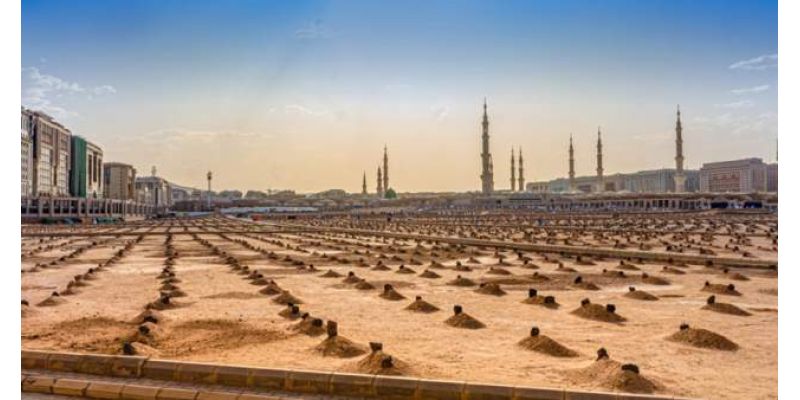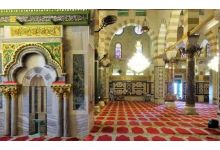- Home
- Islam
- Prayer Timings
- Ramadan
- Quran Kareem
- Hadith
- Hajj/Umrah
- Muslim Calandar
- Islamic Info
-
Naats
- Famous Naat Khawan
- Atif Aslam Naats
- Junaid Jamshed Naats
- Amir Liaquat Hussain Naats
- Abdul Rauf Rufi Naats
- Siddique Ismail Naats
- Yousaf Memon Naats
- Shehbaz Qamar Fareedi Naats
- Amjad Sabri Naats
- Khursheed Ahmed Naats
- Marghoob Hamdani Naats
- Waheed Zafar Qasmi Naats
- Owais Raza Qadri Naats
- Fasih Ud Din Soherwardi Naats
- Sami Yusuf Naats
- Listen Urdu Naats
- Arabic Naats MP3
- 12 Rabi-ul-Awal Naats MP3
- More
- Home
- Islam
- Information
- Jannat Ul Baqi Graveyard History And Complete Information For You To Read And Share
Jannat Ul Baqi Graveyard History And Complete Information For You To Read And Share

Here is the Jannat Ul Baqi Graveyard History and Complete Information that will allow you to know how vital this graveyard is for Muslims. Jannatul Baqi, Garden of Baqi, Baqi al-Gharqad, or Baqi of the Boxthorn are the common names for this graveyard. However, two more cemeteries were used in Madinah, namely Bani Salim and Bani Haram. But within no time, due to our Holy Prophet Hazrat Muhammad (SAW), Jannat Ul Baqi became the main cemetery in the city of Madina. The graveyard is located southeast of Masjid al-Nabawi. Above all, this graveyard has the graves of some of the most prominent personalities in Islamic history. It is said that there are around 10,000 companions of our Holy Prophet Hazrat Muhammad (SAW) buried here. But due to the demolition of this graveyard in 1925 by the House of Saud, there are no identities left with the graves.
The Holy Prophet Hazrat Muhammad (SAW) is reported to have said:
“From this cemetery (i.e., Baqi) emerges a light that will illuminate the heavens and the Earth.”
Location and size of the Jannat Ul Baqi
The combined size of Jannat Ul Baqi in history was around 80m2.
(جاری ہے)
But as time changed and the requirements for graveyards, the size of Jannat Ul Baqi Graveyard changed. Now Jannat Ul Baqi Graveyard sprawls around a 175,000m2 area, and it underwent the extensions in the year 1373, in the year 1953-1954, respectively. The Jannat Ul Baqi graveyard has three entrances. One on the north, another on the east. The main entrance is from the western side of the graveyard. This main entrance is used by the visitors and those who come here to have burials. The combined area between Jannatul Baqi and Masjid Nabawi is known as Bayn al-Haramayn.
Holy Prophet Hazrat Muhammad (SAW) “Verily Allah will command, on the Day of Resurrection, that Juhun and Baqi are taken and placed in Paradise, and those who are buried in our cemetery (Baqi) will attain my intercession.”
History
There were Ahl al-Bayt houses and a marketplace that used to be here in old times. But they no longer exist. A white marble plaza has replaced them. If you stand on the eastern exit of Masjid Nabawi, you can see the entrance of Jannatul Baqi. The first companion of our Holy Prophet Hazrat Muhammad (SAW) buried in Jannatul Baqi was As’ad ibn Zurarah from the Khazraj tribe of Madinah. Further, the first from the Muhajirun to be buried in Jannatul Baqi was Uthman ibn Maz’un.
Daughters of Prophet Muhammad (SAW) buried in Jannat Ul Baqi Graveyard
Bibi Umm Kulthum
Bibi Ruqayya
Bibi Zaynab
Wives of Prophet Muhammad (SAW) buried in Jannat Ul Baqi Graveyard
Bibi Aisha bint Abu Bakr as-Siddiq
Bibi Sawda bint Zam’a
Bibi Hafsa bint Umar ibn al-Khattab
Bibi Zaynab bint Khuzayma
Bibi Umm Salama bint Abi Umayya
Bibi Juwayriyya bint al-Harith
Bibi Umm Habiba, Ramla bint Abi Sufyan
Bibi Safiyya bint Huyayy
Bibi Zaynab bint Jahsh
Ahl Al Bayt Buried in Jannat Ul Baqi Graveyard
Hazrat Al-Hasan ibn Ali ibn Ali Talib
Hazrat Bibi Fatima
Hazrat Ali ibn Husain Zayn al-Abidin
Hazrat Muhammad al-Baqir
Hazrat Ja’far al-Sadiq
Hazrat Al-Abbas ibn Abdul Muttalib
Relatives of Prophet Muhammad (SAW) buried in Jannat Ul Baqi Graveyard
Hazrat Aqil ibn Abi Talib
Hazrat Abdullah ibn Jafar al-Tayyar
Hazrat Abu Sufyan ibn al-Harith
Bibi Halima al-Sa’diyya
Write Your Comments
More Islamic Information

Does Fajr Start At Dawn

Umrah Visa Policy For UAE citizens is out there

Shab E Barat Nawafil

Hifazat Ki Dua - Dua and Prayers for Protection Against Coronavirus

Surah Fatiha Benefits

Ayatul Kursi Ke Fayde, Fazilat or Wazifa for Muslims

What are the five pillars of Islam?

15 Shaban Importance In Islam explains the virtues of the night

How many Sajdah in Quran?

Mihrab and Mimbar of Masjid Al Aqsa - Key Facts and Information

Which animals can be sacrificed on Eid ul Adha

Jannat Ul Baqi Graveyard History and Complete Information for you to read and share